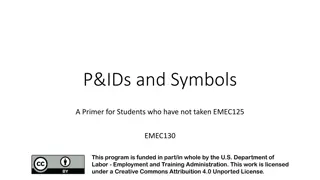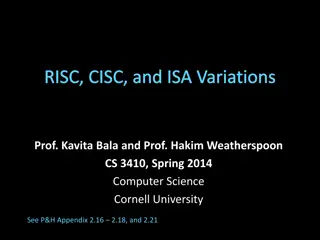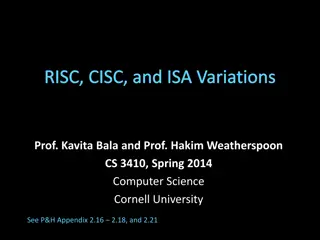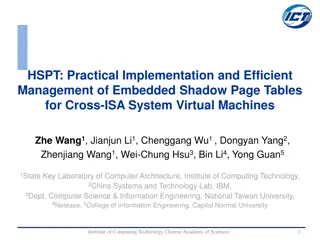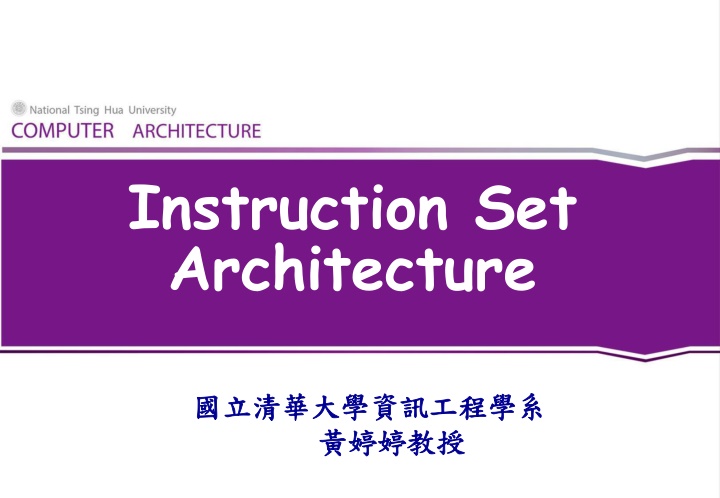
Instruction Set Architecture and Computer Organization
Delve into the world of Instruction Set Architecture (ISA) and Machine Organization, exploring operands such as registers and memory, data transfer, logical operations, decision-making processes, and more. Learn about the attributes of computing systems as perceived by programmers and the nuances of translating code to assembly language. Discover the components of an ISA, including programmable storage, data types, instruction formats, and ALU operations.
Uploaded on | 0 Views
Download Presentation

Please find below an Image/Link to download the presentation.
The content on the website is provided AS IS for your information and personal use only. It may not be sold, licensed, or shared on other websites without obtaining consent from the author. If you encounter any issues during the download, it is possible that the publisher has removed the file from their server.
You are allowed to download the files provided on this website for personal or commercial use, subject to the condition that they are used lawfully. All files are the property of their respective owners.
The content on the website is provided AS IS for your information and personal use only. It may not be sold, licensed, or shared on other websites without obtaining consent from the author.
E N D
Presentation Transcript
Instruction Set Architecture
Outline Instruction set architecture Operands Register operands and their organization Memory operands, data transfer Immediate operands Signed and unsigned numbers Representing instructions Operations Logical Decision making and branches Supporting procedures in hardware Communicating with people Addressing for 32-bit immediate and addresses Translating and starting a program A sort example Arrays versus pointers ARM and x86 instruction sets 1
Outline Instruction set architecture Operands Register operands and their organization Memory operands, data transfer Immediate operands Signed and unsigned numbers Representing instructions Operations Logical Decision making and branches Supporting procedures in hardware Communicating with people Addressing for 32-bit immediate and addresses Translating and starting a program A sort example Arrays versus pointers ARM and x86 instruction sets 2
What Is Computer Architecture? Computer Architecture = Instruction Set Architecture + Machine Organization ... the attributes of a [computing] system as seen by the [____________ language] programmer, i.e. the conceptual structure and functional behavior assembly What are specified? 3
Recall in C Language Operators: +, -, *, /, % (mod), ... 7/4==1, 7%4==3 Operands: Variables: lower, upper, fahr, celsius Constants: 0, 1000, -17, 15.4 Assignment statement: variable = expression Expressions consist of operators operating on operands, e.g., celsius = 5*(fahr-32)/9; a = b+c+d-e; 4
When Translating to Assembly ... a = b + 5; Statement load load add store $r1, M[b] $r2, 5 $r3, $r1, $r2 $r3, M[a] Constant Operands Memory Register Operator (op code) 5
Components of an ISA Organization of programmable storage registers memory: flat, segmented modes of addressing and accessing data items and instructions Data types and data structures encoding and representation Instruction formats Instruction set (or operation code) ALU, control transfer, exceptional handling 6
MIPS ISA as an Example Registers Instruction categories: Load/Store Computational Jump and Branch Floating Point Memory Management Special $r0 - $r31 PC HI LO 3 Instruction Formats: all 32 bits wide OP $rs $rd sa funct $rt immediate OP $rs $rt jump target OP 7
Outline Instruction set architecture Operands Register operands and their organization Memory operands, data transfer Immediate operands Signed and unsigned numbers Representing instructions Operations Logical Decision making and branches Supporting procedures in hardware Communicating with people Addressing for 32-bit immediate and addresses Translating and starting a program A sort example Arrays versus pointers ARM and x86 instruction sets 8
Operations of Hardware Syntax of basic MIPS arithmetic/logic instructions: 1 2 3 4 add $s0,$s1,$s2 # f = g + h 1) operation by name 2) operand getting result ( destination ) 3) 1st operand for operation ( source1 ) 4) 2nd operand for operation ( source2 ) Each instruction is 32 bits Syntax is rigid: 1 operator, 3 operands Why? Keep hardware simple via regularity Design Principle 1: Simplicity favors regularity Regularity makes implementation simpler Simplicity enables higher performance at lower cost 9
Example How to do the following C statement? f = (g + h) - (i + j); Compiled MIPS code: add t0, g, h # temp t0 = g + h add t1, i, j # temp t1 = i + j sub f, t0, t1 # f = t0 - t1 10
Operands and Registers Unlike high-level language, assembly don t use variables => assembly operands are registers Limited number of special locations built directly into the hardware Operations are performed on these Benefits: Registers in hardware => faster than memory Registers are easier for a compiler to use e.g., as a place for temporary storage Registers can hold variables to reduce memory traffic and improve code density (since register named with fewer bits than memory location) 11
MIPS Registers 32 registers, each is 32 bits wide Why 32? Design Principle 2: smaller is faster Groups of 32 bits called a word in MIPS Registers are numbered from 0 to 31 Each can be referred to by number or name Number references: $0, $1, $2, $30, $31 By convention, each register also has a name to make it easier to code, e.g., $16 - $23 $s0 - $s7 (C variables) $8 - $15 $t0 - $t7 (temporary) 32 x 32-bit FP registers (paired DP) Others: HI, LO, PC 12
Registers Conventions for MIPS 0 zero constant 0 16 s0 callee saves 1 at reserved for assembler . . . (caller can clobber) 2 v0 expression evaluation & 23 s7 3 v1 function results 24 t8 temporary (cont d) 4 a0 arguments 25 t9 5 a1 26 k0 reserved for OS kernel 6 a2 27 k1 7 a3 28 gp pointer to global area 8 t0 temporary: caller saves 29 sp stack pointer . . . (callee can clobber) 30 fp frame pointer 15 t7 31 ra return address (HW) Fig. 2.18 13
Memory MIPS R2000 Organization CPU Coprocessor 1 (FPU) Registers Registers $0 $0 $31 $31 Arithmetic unit Multiply divide Arithmetic unit Lo Hi Coprocessor 0 (traps and memory) Fig. A.10.1 Registers BadVAddr Cause Status EPC 14
Example How to do the following C statement? f = (g + h) - (i + j); f, , j in $s0, , $s4 use intermediate temporary register t0,t1 add $t0,$s1,$s2 add $t1,$s3,$s4 sub $s0,$t0,$t1 # t0 = g + h # t1 = i + j # f=(g+h)-(i+j) 15
Register Architecture Accumulator (1 register): 1 address: add A 1+x address: addx A acc Stack: 0 address: add General Purpose Register: 2 address: add A,B EA(A) 3 address: add A,B,C EA(A) Load/Store: (a special case of GPR) 3 address: add load store acc acc + mem[A] acc + mem[A+x] tos tos + next EA(A) + EA(B) EA(B) + EA(C) $ra,$rb,$rc $ra $ra,$rb $ra,$rb $rb + $rc $ra mem[$rb] mem[$rb] $ra 16
Register Organization Affects Programming Code for C = A + B for four register organizations: Stack Accumulator Register Push A Load A Push B Add B Add Store C Pop C Register (reg-mem) (load-store) Load $r1,A Load $r1,A Add $r1,B Load $r2,B Store C,$r1 Add $r3,$r1,$r2 Store C,$r3 => Register organization is an attribute of ISA! Comparison: Byte per instruction? Number of instructions? Cycles per instruction? Since 1975 all machines use GPRs 17
Outline Instruction set architecture Operands Register operands and their organization Memory operands, data transfer Immediate operands Signed and unsigned numbers Representing instructions Operations Logical Decision making and branches Supporting procedures in hardware Communicating with people Addressing for 32-bit immediate and addresses Translating and starting a program A sort example Arrays versus pointers ARM and x86 instruction sets 18
Memory Operands C variables map onto registers; what about large data structures like arrays? Memory contains such data structures But MIPS arithmetic instructions operate on registers, not directly on memory Data transfer instructions (lw, sw, ...) to transfer between memory and register A way to address memory operands 19
Data Transfer: Memory to Register (1/2) To transfer a word of data, need to specify two things: Register: specify this by number (0 - 31) Memory address: more difficult Each address is 32 bits Think of memory as a 1D array Address it by supplying a pointer to a memory address Offset (in bytes) from this pointer The desired memory address is the sum of these two values, e.g., 8($t0) Specifies the memory address pointed to by the value in $t0, plus 8 bytes (why bytes , not words ?) 20
Data Transfer: Memory to Register (2/2) Load Instruction Syntax: 1 2 3 4 lw $t0,12($s0) 1) operation name 2) register that will receive value 3) numerical offset in bytes 4) register containing pointer to memory Example: lw $t0,12($s0) lw (Load Word, so a word (32 bits) is loaded at a time) Take the pointer in $s0, add 12 bytes to it, and then load the value from the memory pointed to by this calculated sum into register $t0 Notes: $s0 is called the base register, 12 is called the offset Offset is generally used in accessing elements of array: base register points to the beginning of the array 21
Example $s0 = 1000 Memory 1000 lw $t0, 12($s0) 1004 999 $t0 = ? 1008 1012 999 1016 Instruction Set-22 22
Data Transfer: Register to Memory Also want to store value from a register into memory Store instruction syntax is identical to Load instruction syntax Example: sw $t0,12($s0) sw (meaning Store Word, so 32 bits or one word are stored at a time) This instruction will take the pointer in $s0, add 12 bytes to it, and then store the value from register $t0 into the memory address pointed to by the calculated sum 23
Example $s0 = 1000 $t0 = 25 Memory 1000 1004 sw $t0, 12($s0) 1008 M[?] = 25 M[1012] = 25 1012 25 1016 Instruction Set-24 24
Compilation with Memory Compile by hand using registers: $s1:g, $s2:h, $s3:base address of A g = h + A[8]; What offset in lw to select an array element A[8] in a C program? 4x8=32 bytes to select A[8] 1st transfer from memory to register: lw $t0,32($s3) Add 32 to $s3 to select A[8], put into $t0 # $t0 gets A[8] Next add it to h and place in g add $s1,$s2,$t0 # $s1 = h+A[8] 25
Memory Operand Example 2 C code: A[12] = h + A[8]; A[12] = h + A[8]; h in $s2, base address of A in $s3 Compiled MIPS code: Index 8 requires offset of a lw lw $t0 $t0, a , a($s3) # load word ($s3) # load word add $t0, $s2, $t0 add $t0, $s2, $t0 sw sw $t0, $t0, b b($s3) # store word ($s3) # store word = 32 a a = b b = 48 = 48 26
Addressing: Byte versus Word Every word in memory has an address, similar to an index in an array Early computers numbered words like C numbers elements of an array: Memory[0], Memory[1], Memory[2], Called the address of a word Computers need to access 8-bit bytes as well as words (4 bytes/word) Today, machines address memory as bytes, hence word addresses differ by 4 Memory[0], Memory[4], Memory[8], This is also why lw and sw use bytes in offset 27
A Note about Memory: Alignment MIPS requires that all words start at addresses that are multiples of 4 bytes 0 1 2 3 Aligned Not Aligned Called Alignment: objects must fall on address that is multiple of their size 28
Another Note: Endianess Byte order: numbering of bytes within a word Big Endian: address of most significant byte at least address of a word IBM 360/370, Motorola 68k, MIPS, Sparc, HP PA Little Endian: address of least significant byte at least address Intel 80x86, DEC Vax, DEC Alpha (Windows NT) little endian byte 0 3 2 1 0 msb lsb 0 1 2 3 big endian byte 0 word address 29
Role of Registers vs. Memory What if more variables than registers? Compiler tries to keep most frequently used variables in registers Writes less common variables to memory: spilling Why not keep all variables in memory? Smaller is faster: registers are faster than memory Registers more versatile: MIPS arithmetic instructions can read 2 registers, operate on them, and write 1 per instruction MIPS data transfers only read or write 1 operand per instruction, and no operation 30
Outline Instruction set architecture Operands Register operands and their organization Memory operands, data transfer Immediate operands Signed and unsigned numbers Representing instructions Operations Logical Decision making and branches Supporting procedures in hardware Communicating with people Addressing for 32-bit immediate and addresses Translating and starting a program A sort example Arrays versus pointers ARM and x86 instruction sets 31
Constants Small constants used frequently (50% of operands) e.g., A = A + 5; B = B + 1; C = C - 18; Put 'typical constants' in memory and load them Constant data specified in an instruction: addi $29, $29, 4 slti $8, $18, 10 andi $29, $29, 6 ori $29, $29, 4 Design Principle 3: Make the common case fast 32
Immediate Operands Immediate: numerical constants Often appear in code, so there are special instructions for them Add Immediate: f = g + 10 (in C) addi $s0,$s1,10 (in MIPS) where $s0,$s1 are associated with f,g Syntax similar to add instruction, except that last argument is a number instead of a register No subtract immediate instruction Just use a negative constant addi $s2, $s1, -1 33
The Constant Zero The number zero (0), appears very often in code; so we define register zero MIPS register 0 ($zero) is the constant 0 Cannot be overwritten This is defined in hardware, so an instruction like addi $0,$0,5 will not do anything Useful for common operations E.g., move between registers add $t2, $s1, $zero add $t2, $s1, $zero 34
Outline Instruction set architecture Operands Register operands and their organization Memory operands, data transfer Immediate operands Signed and unsigned numbers (read by students) Representing instructions Operations Logical Decision making and branches Supporting procedures in hardware Communicating with people Addressing for 32-bit immediate and addresses Translating and starting a program A sort example Arrays versus pointers ARM and x86 instruction sets 35
Outline Instruction set architecture Operands Register operands and their organization Memory operands, data transfer Immediate operands Signed and unsigned numbers Representing instructions Operations Logical Decision making and branches Supporting procedures in hardware Communicating with people Addressing for 32-bit immediate and addresses Translating and starting a program A sort example Arrays versus pointers ARM and x86 instruction sets 36
Outline Instruction set architecture Operands Register operands and their organization Memory operands, data transfer Immediate operands Signed and unsigned numbers Representing instructions Operations Logical Decision making and branches Supporting procedures in hardware Communicating with people Addressing for 32-bit immediate and addresses Translating and starting a program A sort example Arrays versus pointers ARM and x86 instruction sets 37
Instructions as Numbers Currently we only work with words (32-bit blocks): Each register is a word lw and sw both access memory one word at a time So how do we represent instructions? Remember: Computer only understands 1s and 0s, so add $t0,$0,$0 is meaningless to hardware MIPS wants simplicity: since data is in words, make instructions be words 38
MIPS Instruction Format One instruction is 32 bits => divide instruction word into fields Each field tells computer something about instruction We could define different fields for each instruction, but MIPS is based on simplicity, so define 3 basic types of instruction formats: R-format: for register I-format: for immediate, and lw and sw (since the offset counts as an immediate) J-format: for jump 39
R-Format Instructions (1/2) Define the following fields : 6 5 rs 5 rt 5 rd 5 6 opcode opcode: partially specifies what instruction it is (Note: 0 for all R-Format instructions) funct: combined with opcode to specify the instruction Question: Why aren t opcode and funct a single 12-bit field? rs (Source Register): generally used to specify register containing first operand rt (Target Register): generally used to specify register containing second operand rd (Destination Register): generally used to specify register which will receive result of computation shamt funct 40
R-Format Instructions (2/2) Notes about register fields: Each register field is exactly 5 bits, which means that it can specify any unsigned integer in the range 0-31. Each of these fields specifies one of the 32 registers by number. Final field: shamt: contains the amount a shift instruction will shift by. Shifting a 32-bit word by more than 31 is useless, so this field is only 5 bits This field is set to 0 in all but the shift instructions 41
R-format Example op rs rt rd shamt funct 6 bits 5 bits 5 bits 5 bits 5 bits 6 bits add $t0, $s1, $s2 add $t0, $s1, $s2 Special $s1 $s2 $t0 0 add 0 17 18 8 0 32 000000 10001 10010 01000 00000 100000 000000100011001001000000001000002 = 0232402016 42
Hexadecimal Base 16 Compact representation of bit strings 4 bits per hex digit 0 1 2 3 0000 0001 0010 0011 4 5 6 7 0100 0101 0110 0111 8 9 a b 1000 1001 1010 1011 c d e f 1100 1101 1110 1111 Example: eca8 6420 1110 1100 1010 1000 0110 0100 0010 0000 43
I-Format Instructions Define the following fields : 6 5 rs 5 rt 16 opcode opcode: uniquely specifies an I-format instruction rs: specifies the only register operand rt: specifies register which will receive result of computation (target register) addi, slti, immediate is sign-extended to 32 bits, and treated as a signed integer 16 bits can be used to represent immediate up to 216 different values immediate 44
MIPS I-format Instructions Design Principle 4: Good design demands good compromises Different formats complicate decoding, but allow 32-bit instructions uniformly Keep formats as similar as possible 45
I-Format Example 1 MIPS Instruction: addi $21,$22,-50 opcode = 8 (look up in table) rs = 22 (register containing operand) rt = 21 (target register) immediate = -50 (by default, this is decimal) decimal representation: 8 22 21 -50 binary representation: 001000 10110 10101 1111111111001110 46
I-Format Example 2 MIPS Instruction: lw $t0,1200($t1) opcode = 35 (look up in table) rs = 9 (base register) rt = 8 (destination register) immediate = 1200 (offset) decimal representation: 35 binary representation: 9 8 1200 100011 01001 01000 0000010010110000 47
Stored Program Computers Instructions represented in binary, just like data Instructions and data stored in memory Programs can operate on programs e.g., compilers, linkers, Binary compatibility allows compiled programs to work on different computers Standardized ISAs The BIG Picture The BIG Picture Memory Accounting program (machine code) Editor program (machine code) C compiler (machine code) Processor Payroll data Book text Source code in C For editor program 48
Outline Instruction set architecture Operands Register operands and their organization Memory operands, data transfer Immediate operands Signed and unsigned numbers Representing instructions Operations Logical Decision making and branches Supporting procedures in hardware Communicating with people Addressing for 32-bit immediate and addresses Translating and starting a program A sort example Arrays versus pointers ARM and x86 instruction sets 49












